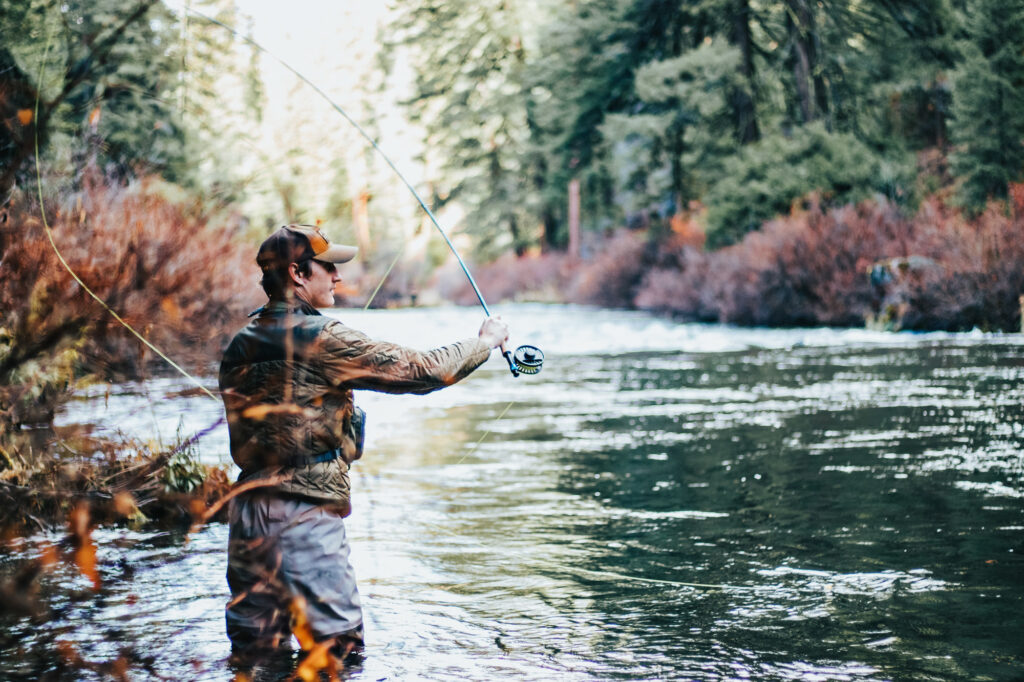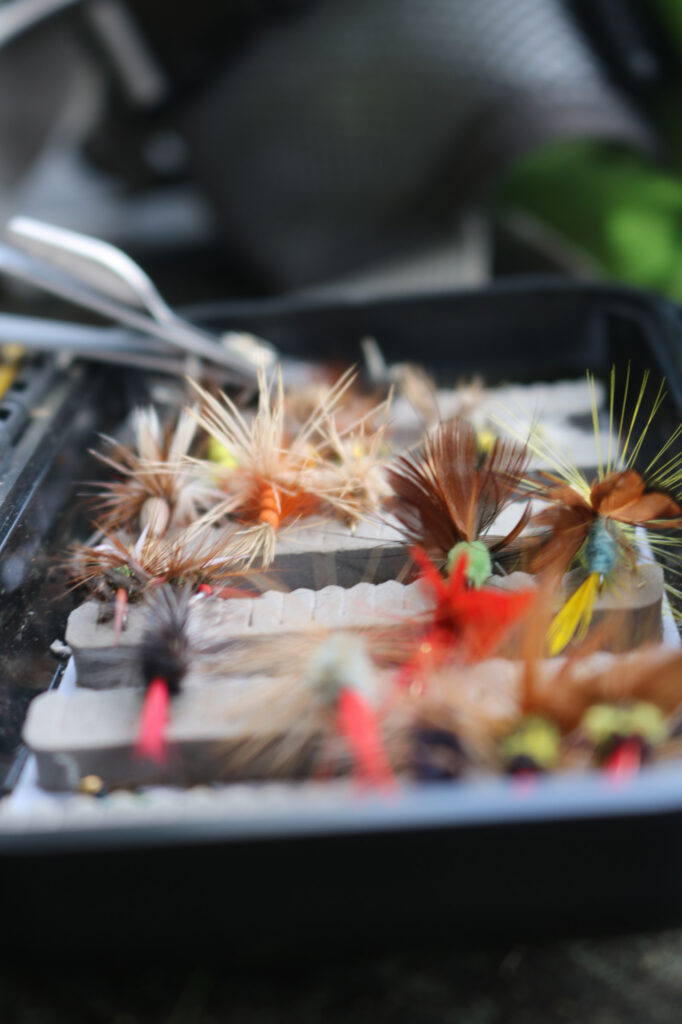
“One of the most appealing parts of fly fishing in Washington state is the sheer range; we are essentially blessed with five climates that provide completely different fisheries and experiences. You’ve got everything from the rainforests of the Olympic Peninsula to the drier, more arid environment of the Klickitat River Valley or the Yakima River in Eastern Washington; there are glacial rivers, high mountain streams, basins, tributaries, tiny little streams on up to the mighty Columbia River. It’s an outdoorsman’s paradise.”
This apt summation of our state’s earthly attributes comes from Jeff Brazda, the owner of an Ellensburg-based fly fishing guide outfit that spends most of the calendar year spiriting visitors to local rivers in search of their next catch. Yes, Washington can, and does, offer up the quintessential image many conjure when the words “fly fishing” are uttered—wading out into a pristine stream to cast a line time and again before pulling a wiggling, waggling rainbow trout out of the flowing waters. But, the state’s aforementioned geographical diversity also allows anglers to fly fish the salt, with myriad options for nabbing cutthroat from both the sea and beaches.
September marks a prime time for fishing, as aficionados can capitalize on both the last fringes of summer salmon season, as well as look for freshwater favorites like trout. Here, three local fly fishing experts chime in on their favorite tactics, proven methods, and the go-to fishing holes they’ll frequent this fall season, as well as also offer advice for aspiring anglers and experts alike. Whether you decide to aim upriver, stick to the shallows, or mosey down to the beach, all three agree on one thing: it’s definitely time to let it fly.
HEADING UPRIVER
For Jeff Brazda of Brazda’s Fly Fishing, the entire pursuit is all about family. With deep roots in the Methow Valley, he got his start tying flies alongside his grandfather beginning at age seven and fished the Methow extensively during his formative years. Now, for the past 17 years, he has made his living by spiriting other families on both single- and multi-day guided fly fishing trips for both steelhead and trout, primarily up the Methow, Klickitat, and Yakima Rivers, but also on the Olympic Peninsula, as well. “It’s not always about catching the most fish or the biggest fish,” he explains. “The best part is spending time with family and friends; getting out into nature together; having a fun guide lead the way. We laugh a lot out there.”
When it comes to fall, Brazda is looking to the Yakima River to provide a healthy amount of trout for the taking, beginning now and on into November. (This spot is also where anglers will find that postcard-perfect image of fly fishing from the rock-cobbled river banks; the Yakima is, in fact, considered the state’s only “Blue Ribbon” trout fishery.) Come winter, Brazda will, as always, head west to the glistening and gorgeous rivers found on the Peninsula, where he owns and operates an overnight fishing lodge, the Wild Duc, located just outside Forks on the Sol Duc River.
“The overnight stays really give you an opportunity to immerse yourself in fishing culture, really learn about the species you are after, and bond with the guides and the rest of the group. It’s a great deep dive into fly fishing at its purest.” One tip he always shares on those trips: Northwest trout love stoneflies, which are readily found sitting on the surface of the water, and Brazda swears by this old-school bait. He often ties on a simple Chernobyl Ant fly that mimics that humble bug.
While the guided sojourns by Brazda’s Fly Fishing are ideal for novices or those looking to bulk up their knowledge—the team provides all the necessary gear, and the expertise in identifying the spots fish like to frequent, like under cool shady autumn leaves, for example—Brazda stresses that aspiring anglers shouldn’t be intimidated by the sport. “Anyone can learn to cast, go to YouTube and watch a few videos and you’ll get the hang of it with just a little practice. And be sure to frequent your local fly shops or call the local guides, they’ll know the area the best.”
PLAYING IN THE SHALLOW END
Moving from the rivers out west to the sea, anglers can sleuth out perhaps a more surprising spot for cutthroat trout: the saltwater shallows. These anadromous trout are born in our rivers, yes, but then migrate to saltwater areas before returning to spawn in their natal stream, and as such spend a chunk of the year in ocean and saltwater estuaries.
And Sound Fly Fishing owner and guide Ben Zander—who was first introduced to the idea of fly fishing coastal cutthroat off Camano Island almost 20 years ago by a friend—seems to have figured out the combination to lure these cutthroats in: by ever so slowly trolling sand bars by boat. “I think every guide has their own philosophy on how they run the day or game plan, but I really like to focus on shallow water,” he explains. “Sight fishing for these critters is not really an option but when fishing eelgrass beds, you can watch the fish move over sand to another bed. Then we make the shot.”
Though he runs a 2,600-pound Boston Montauk boat, Zander often utilizes a push pole to gently glide his vessel through the shallows, an idea he got from his experience hunting tarpon and bonefish. “A lot of those guides use a push pole with a smaller skiff for shallow water pursuits. Mine is not a light boat nor is a poling platform really an option. However, I decided to try it, and holy cow, it’s hard work but deadly effective. I love the teamwork between the angler and guide. It makes the day so much fun.”
In addition to his stealth-like approach, Zander often uses a sinking fly to target the trout. “People often think of fly fishing as a dry fly (a surface floating fly). This is a lot of fun but not a productive method when imitating a small fry or baitfish pattern in a saltwater location with waves affecting the sink rate,” he explains. “So, I use intermediate sinking fly lines to get flies in 2-4 feet of water.” He jokes that though he probably has thousands of flies on board for a guided trip, this technique means he really only uses three: a Baitfish Minnow, and a Skinny Herring and Skinny Smolt of his own design, all of which are readily available at Pacific Fly Fishers in Mill Creek, Washington, where Zander can often be found helping anglers in between trips.
Though Zander is explicit when it comes to his cutthroat tactics, he is much more vague on his go-to spots for the fall, in classic fisherperson fashion: “I focus on the waters surrounding Bainbridge and Vashon Islands. That’s all I can say!”
RUNNING ON THE BEACH
If you’ve ever happened to spot a solitary figure fly fishing from a Washington State Park beach, chances are you have happened upon Leland Miyawaki in his element.
Miyawaki is a well-known figure in the Washington fly fishing world, having managed the Bellevue Orvis store for over 15 years before his retirement two years ago. After spending decades in and around the sport, Miyawaki somewhat boldly proclaims that he no longer fishes the rivers at all, forgoing them instead for the state’s beaches. Here he nabs sea-run cutthroat as they come in with the tide to feed.
“It’s a very unique fishery and a bit of a solitary endeavor,” he says with a laugh. “I’m almost 80 years old and I’ll be the only fly fisher out there. I’ll just sidle up next to all these guys waiting to catch salmon and start throwing my floating fly…those other guys always go nuts when I start pulling cutthroat out of the surf.”
This particular technique requires timing, patience—and a willingness to walk the beach, as the cutthroat usually found in the 30- to 40-foot range of the water’s edge are coming in hungry.
“Check the tide charts: you want to fish on a tide that’s going in or out, preferably the biggest outgoing one of the day, usually in the morning,” Miyawaki recommends, also noting that cutthroat can be one location today and an entirely different one tomorrow. “The fish are in there to eat, not to rest. They are chasing their food with the tide, you should move with it too, so you are keeping with them. Sea-runs are all about walking and stalking.” For bait, he uses a floating fly of his own design called the Miyawaki Beach Popper. Available at area fly fish shops, the popper mimics a crippled baitfish leaving a v-wake as Miyawaki stripes it along the surface; he usually throws his line about 50 feet out at a 45-degree angle. “They’ll see it as they come up to feed, and chase it as I wick it.”
Your best bet for fall is to set a heading south, as Miyawaki states that a large portion of the sea-run cutthroat population emerges in the Tacoma, Olympia, and Shelton areas from the river systems nearby. He points to such southend parks Joemma Beach and Penrose Point, both in Lakebay, as two of his favorite spots. February and March tend to be the scantest as most cutthroat are then up in the natal rivers, but, with proper planning, he says the beaches provide an almost year-round fishery.
“It’s extremely satisfying if you can catch a sea-run cutthroat, it means you’ve done everything just right,” Miyawaki concludes. “It’s challenging, and there are definitely easier fisheries out there, but if you wanted easy, why would you want to fly fish?”
>> More details on Brazda’s guided trips can be found at: brazdasflyfishing.com; and, for more information on Sound Fly Fishing, go to: soundflyfishing.com. For further details on fly fishing Washington’s shores, Miyawaki says you are welcome to flag him down on the beach.
